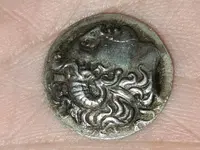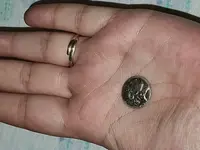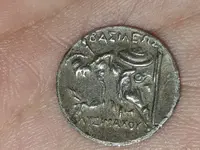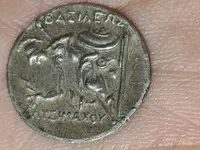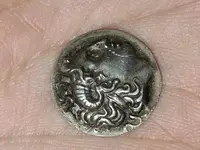You are using an out of date browser. It may not display this or other websites correctly.
You should upgrade or use an alternative browser.
You should upgrade or use an alternative browser.
Is this an original Alexander the great coin or is it an original? Any information?
- Thread starter Saralo
- Start date
What you paid for the coin might indicate whether or not it is real. IF it is real, here is its description:
[h=6]Lysimachos, Kingdom of Thrace, c. 305–281 BCE
Tetradrachm, silver
Obverse: Diademed head of Alexander the Great with horn of Ammon
Reverse: Athena seated on prow, holding Nike, shield, and spear
Inscription: ΒΑΣΙΛΕΩΣ ΛΥΣΙΜΑΧΟΥ (“of King Lysimachos”)[/h][FONT="]As his former general and the new ruler of Thrace, Lysimachos used Alexander the Great’s image to assert his own authority. This portrait depicts Alexander with the ram’s horns of Ammon, an Egyptian deity whose oracle entitled Alexander the “son of Zeus-Ammon.” Although it is unknown whether Alexander actually believed he was a god, he was worshipped as one after his death. Lysimachos thus portrays him as both his political predecessor and his patron deity. To connect Alexander’s glory with his own, his reverse features Athena holding Nike, the bringer of victory, crowning the inscribed “of King Lysimachos.”
Source: Recent Ancient Coin Acquisitions Focus on Alexander the Great | Middlebury College Museum of Art
Don......[/FONT]
[h=6]Lysimachos, Kingdom of Thrace, c. 305–281 BCE
Tetradrachm, silver
Obverse: Diademed head of Alexander the Great with horn of Ammon
Reverse: Athena seated on prow, holding Nike, shield, and spear
Inscription: ΒΑΣΙΛΕΩΣ ΛΥΣΙΜΑΧΟΥ (“of King Lysimachos”)[/h][FONT="]As his former general and the new ruler of Thrace, Lysimachos used Alexander the Great’s image to assert his own authority. This portrait depicts Alexander with the ram’s horns of Ammon, an Egyptian deity whose oracle entitled Alexander the “son of Zeus-Ammon.” Although it is unknown whether Alexander actually believed he was a god, he was worshipped as one after his death. Lysimachos thus portrays him as both his political predecessor and his patron deity. To connect Alexander’s glory with his own, his reverse features Athena holding Nike, the bringer of victory, crowning the inscribed “of King Lysimachos.”
Source: Recent Ancient Coin Acquisitions Focus on Alexander the Great | Middlebury College Museum of Art
Don......[/FONT]
Upvote
0
Similar threads
- Replies
- 0
- Views
- 72
- Question
🔎 UNIDENTIFIED
Any ideas/information is appreciated thanks.. 2 objects
- Replies
- 14
- Views
- 700
Users who are viewing this thread
Total: 1 (members: 0, guests: 1)

